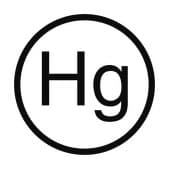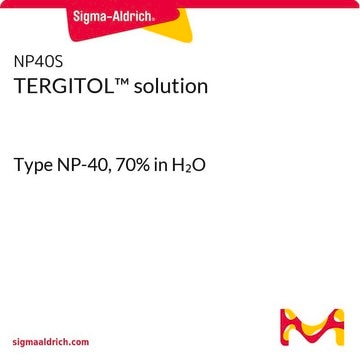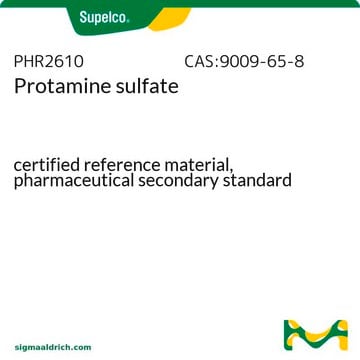Recommended Products
form
saline suspension
matrix
Cross-linked 4% beaded agarose
matrix activation
cyanogen bromide
matrix attachment
amino
matrix spacer
1 atom
capacity
~50 μg/mL binding capacity (DNA)
storage temp.
2-8°C
Application
Protamine-agarose is used in protein chromatography, affinity chromatography and specialty resins. Protamine-agarose has been used to determine that Pichia pastoris (methylotrophic yeast) provides a convenient heterologous system for the production of recombinant subunits of human type 2A protein phosphatase (PP2A). Protamine-agarose has also been used to purify and characterize a novel protamine kinase in HL60 cells as well as to study myocardial infarction.
Physical form
Suspension in 0.5 M NaCl containing 0.02% thimerosal
Disclaimer
For U.S. Customers: Contains mercury; Do not place in trash - dispose according to local, state, or federal laws.


Storage Class Code
12 - Non Combustible Liquids
WGK
WGK 3
Flash Point(F)
Not applicable
Flash Point(C)
Not applicable
Regulatory Listings
Regulatory Listings are mainly provided for chemical products. Only limited information can be provided here for non-chemical products. No entry means none of the components are listed. It is the user’s obligation to ensure the safe and legal use of the product.
EU REACH Annex XVII (Restriction List)
CAS No.
Choose from one of the most recent versions:
Already Own This Product?
Find documentation for the products that you have recently purchased in the Document Library.
S Shibata et al.
Journal of biochemistry, 112(4), 552-556 (1992-10-01)
Calphobindins (CPBs, placental annexins) are intracellular Ca(2+)- and phospholipid-dependent proteins like protein kinase C [EC 2.7.1.37]. We investigated the inhibitory effects of calphobindins on the protein kinase C activity in vitro. CPB I inhibited the protein kinase C activity for
I M Helander et al.
European journal of biochemistry, 163(1), 51-55 (1987-02-16)
The ability of agarose-linked protamine to bind Salmonella typhimurium lipopolysaccharides was investigated. Radioactively labelled lipopolysaccharides were isolated both from a smooth strain (SH6749, labelled with [14C]galactose) and from a rough strain (SH5014, lipopolysaccharide chemotype Rb2, labelled with [3H]acetate). From 50-micrograms
M Junco et al.
FEBS letters, 263(1), 169-171 (1990-04-09)
Protein kinase C (PKC) and its proteolysis-derived protein kinase independent of Ca2+ and phospholipids (PKM), were purified from rat brain. By using histone H1 and protamine as substrates, we assayed the effect of several inhibitors of PKC and PKM. The
V B Lokeshwar et al.
The Journal of biological chemistry, 264(32), 19318-19326 (1989-11-15)
Treatment of Swiss mouse 3T3 cells and human epidermoid carcinoma A431 cells with protamine at 37 degrees C increased the 125I-epidermal growth factor (EGF) binding activity at 4 degrees C. The effect of protamine on the increase of 125I-EGF binding
L Boscá et al.
The Biochemical journal, 290 ( Pt 3), 827-832 (1993-03-15)
The structural changes following the binding to protein kinase C (PKC) of activators that promote its translocation to lipid environments were studied by far-u.v. c.d. and intrinsic fluorescence measurements of the protein. In the absence of activators, PKC contained 40%
Our team of scientists has experience in all areas of research including Life Science, Material Science, Chemical Synthesis, Chromatography, Analytical and many others.
Contact Technical Service






